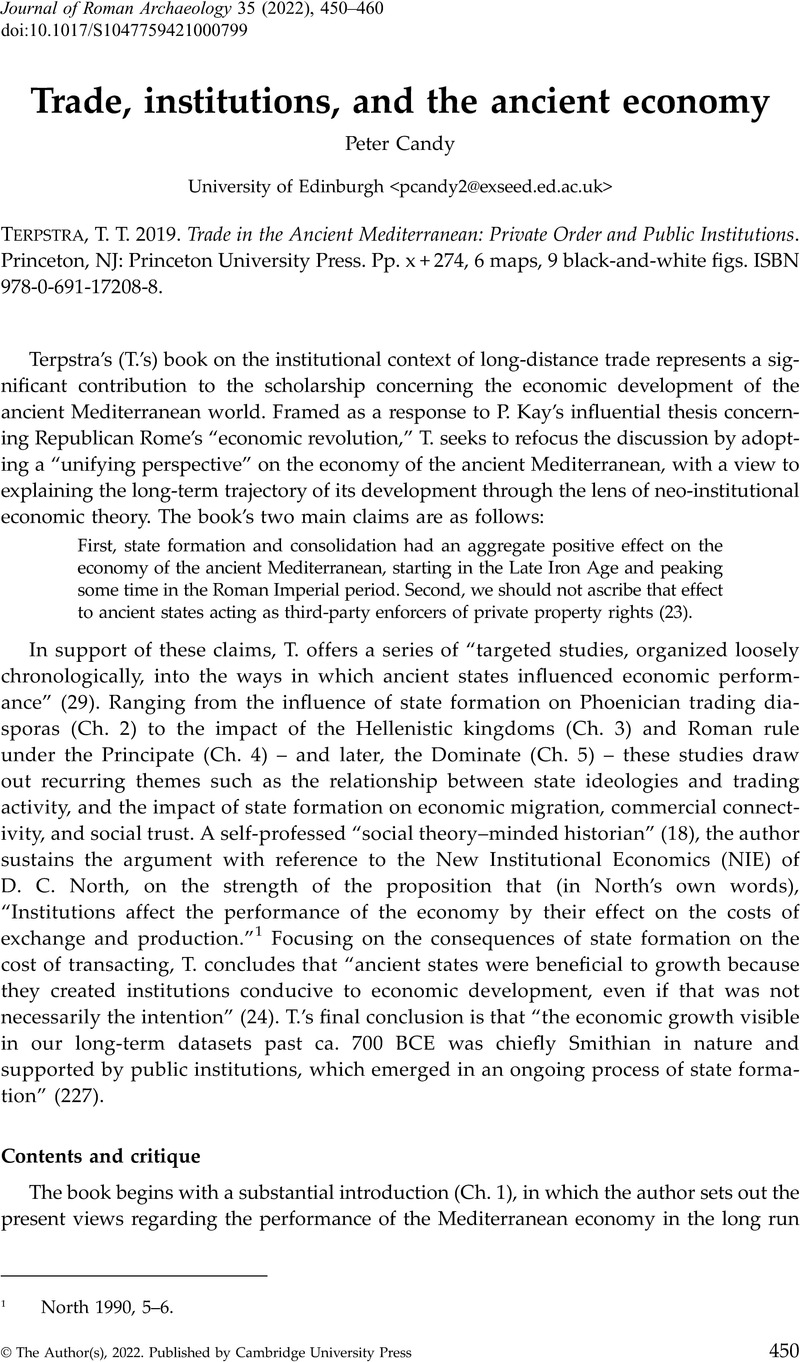No CrossRef data available.
Article contents
Trade, institutions, and the ancient economy - T. T. Terpstra 2019. Trade in the Ancient Mediterranean: Private Order and Public Institutions. Princeton, NJ: Princeton University Press. Pp. x + 274, 6 maps, 9 black-and-white figs. ISBN 978-0-691-17208-8.
Review products
T. T. Terpstra 2019. Trade in the Ancient Mediterranean: Private Order and Public Institutions. Princeton, NJ: Princeton University Press. Pp. x + 274, 6 maps, 9 black-and-white figs. ISBN 978-0-691-17208-8.
Published online by Cambridge University Press: 01 April 2022
Abstract
An abstract is not available for this content so a preview has been provided. Please use the Get access link above for information on how to access this content.

- Type
- Book Review
- Information
- Copyright
- Copyright © The Author(s), 2022. Published by Cambridge University Press
References
Bernard, S. 2020. “Integration, institutions, and the economy of Republican Italy.” Review of Italy's Economic Revolution: Integration and Economy in Republican Italy, by S. T. Roselaar. JRA 33: 563–67.Google Scholar
Blaug, M. 1995a. “Introduction.” In The Quantity Theory of Money: From Locke to Keynes and Friedman, ed. Blaug, M., Eltis, W., O'Brien, D., Patinkin, D., Skidelsky, R., and Wood, G. E., 1–3. Cheltenham: Edward Elgar.Google Scholar
Blaug, M. 1995b. “Why is the quantity theory of money the oldest surviving theory in economics?” In The Quantity Theory of Money: From Locke to Keynes and Friedman, ed. Blaug, M., Eltis, W., O'Brien, D., Patinkin, D., Skidelsky, R., and Wood, G. E., 27–49. Cheltenham: Edward Elgar.Google Scholar
Bowes, K. 2021. “When Kuznets went to Rome: Roman economic well-being and the reframing of Roman history.” Capitalism: A Journal of History and Economics 2: 7–40.CrossRefGoogle Scholar
de Cecco, M. 1985. “Monetary theory and Roman history.” The Journal of Economic History 45, no. 4: 809–22.CrossRefGoogle Scholar
Fisher, I. 1911. The Purchasing Power of Money: Its Determination and Relation to Credit, Interest, and Crises. New York: Macmillan.Google Scholar
Haavelmo, T. 1956. “Ligninger vs. identiteter i økonomisk makroteori.” In 25 Economic Essays in Honour of Erik Lindahl, 68–78. Stockholm: Ekonomisk Tidskrift.Google Scholar
Horden, P., and Purcell, N.. 2000. The Corrupting Sea: A Study of Mediterranean History. Oxford: Blackwell.Google Scholar
Keynes, J. M. 1936. The General Theory of Employment, Interest and Money. London: Macmillan.Google Scholar
Koselleck, R. 2004. Futures Past: On the Semantics of Historical Time. Transl. K. Tribe. New York: Columbia University Press.Google Scholar
Lewis, M. K., and Mizen, P. D.. 2000. Monetary Economics. Oxford and New York: Oxford University Press.Google Scholar
Moss, L. S., and Ryan, C. K., eds. 1993. Economic Thought in Spain: Selected Essays of Marjorie Grice-Hutchinson. Aldershot: Edward Elgar.Google Scholar
Nicholas, J. K. B. M. 2008. An Introduction to Roman Law. 2nd ed. Oxford: Oxford University Press.Google Scholar
North, D. C. 1990. Institutions, Institutional Change and Economic Performance. Cambridge: Cambridge University Press.CrossRefGoogle Scholar
North, D. C., Wallis, J. J., and Weingast, B. R.. 2009. Violence and Social Orders: A Conceptual Framework for Interpreting Recorded Human History. Cambridge: Cambridge University Press.CrossRefGoogle Scholar
Richter, R. 1988. “The new institutional economics applied to monetary economics.” Journal of Institutional and Theoretical Economics 144, no. 1: 208–24.Google Scholar
Scheidel, W. 2011. “A comparative perspective on the determinants of scale and productivity of Roman maritime trade in the Mediterranean.” In Maritime Technology in the Ancient Economy: Ship-Design and Navigation, ed. Harris, W. V. and Iara, K., 21–38. Portsmouth, RI: JRA.Google Scholar
Scheidel, W., ed. 2012. The Cambridge Companion to the Roman Economy. Cambridge: Cambridge University Press.CrossRefGoogle Scholar
Schumpeter, J. A. 2006 [1954]. History of Economic Analysis. Oxford: Routledge.CrossRefGoogle Scholar
Tchernia, A. 2016. The Romans and Trade. Transl. Grieve, J. and Minchin, E.. Oxford: Oxford University Press.CrossRefGoogle Scholar
Verboven, K. 2015. “The knights who say NIE. Can neo-institutional economics live up to its expectation in ancient history research?” In Structure and Performance in the Roman Economy: Models, Methods and Case Studies, ed. Erdkamp, P. and Verboven, K., 33–58. Brussels: Latomus.Google Scholar
von Reden, S. 2002. “Money in the ancient economy: A survey of recent research.” Klio 84, no. 1: 141–74.CrossRefGoogle Scholar
Weber, M. 2013 [1908]. The Agrarian Sociology of Ancient Civilizations. Transl. Frank, R. I.. London: Verso.Google Scholar
Yarbrough, B. V., and Yarbrough, R. M.. 1997. “Dispute settlement in international trade: Regionalism and procedural coordination.” In The Political Economy of Regionalism, ed. Mansfield, E. D. and Milner, H. V., 134–63. New York: Columbia University Press.Google Scholar




